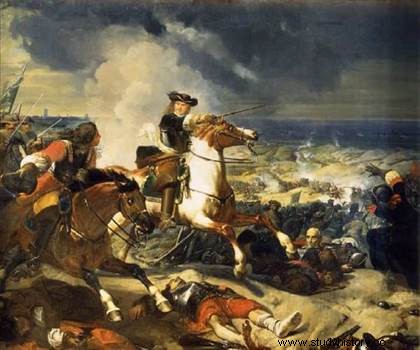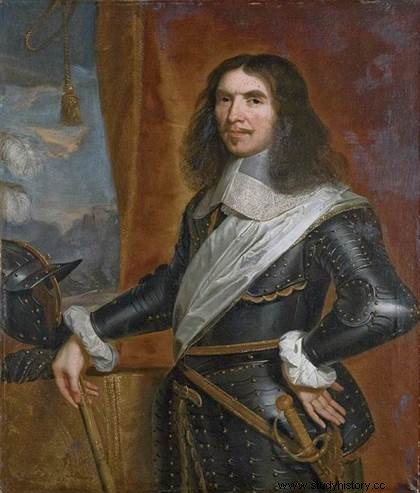 June 14, 1658 at the Battle of the Dunes took place the conclusion of a war which had lasted twenty-five years and opposed France to Spain. The French, commanded by Turenne and allies once is not custom to the English, confront the Spaniards there, one of whose commanders is none other than the Grand Conde , a former slinger. With the victory of the French army, the Louis-quatorzienne epic is announced to Europe.
June 14, 1658 at the Battle of the Dunes took place the conclusion of a war which had lasted twenty-five years and opposed France to Spain. The French, commanded by Turenne and allies once is not custom to the English, confront the Spaniards there, one of whose commanders is none other than the Grand Conde , a former slinger. With the victory of the French army, the Louis-quatorzienne epic is announced to Europe.
The Franco-Spanish Rivalry
Since 1635, the kingdoms of France and Spain have been engaged in a particularly bitter conflict. Hostilities broke out when, under the leadership of Cardinal Richelieu, the armies of France attacked the Spanish Netherlands. Although the Franco-Spanish war is part of the Thirty Years War, it remains the culmination of the deaf rivalry that has opposed the two kingdoms since Francis I. The party that emerged victorious would be able to establish itself as the dominant power in Europe.
 The first phase of the war remained in favor of the Bourbons, as evidenced by the signing of the Treaties of Westphalia which saw Paris get its hands on strategic territories in Alsace. However, with the Fronde breaking out in France, Spain can regain the initiative. The French position is in these troubled years (1648-1653) very difficult. The young Louis XIV, whose regency is exercised by his mother Anne of Austria, will find himself several times at the mercy of the Frondeurs. Cardinal Mazarin, principal minister of the regent and continuator of Richelieu's anti-Spanish policy, was twice forced into exile.
The first phase of the war remained in favor of the Bourbons, as evidenced by the signing of the Treaties of Westphalia which saw Paris get its hands on strategic territories in Alsace. However, with the Fronde breaking out in France, Spain can regain the initiative. The French position is in these troubled years (1648-1653) very difficult. The young Louis XIV, whose regency is exercised by his mother Anne of Austria, will find himself several times at the mercy of the Frondeurs. Cardinal Mazarin, principal minister of the regent and continuator of Richelieu's anti-Spanish policy, was twice forced into exile.
Condé versus Turenne
Spain, which supported the Slingers, hastened to their defeat in 1653 to welcome the surviving armies and leaders. At the head of these exiled French nobles, one of the greatest captains of his time:Louis II, Prince of Condé. Prince of the blood, the one who was the winner of Rocroi (1643) burns to impose himself on the young Louis XIV. Condé was not an early Frondeur. He only joined the rebels after realizing that the King still preferred Mazarin to him. Archetypal of the “Great”, he is a fiery general famous for his daring cavalry charges. From 1653 he will therefore serve the throne of Spain and confront his great rival:Turenne.
Henri de la Tour d'Auvergne, Viscount of Turenne is also a "Grand", from one of the most prestigious families in Europe. Educated in the Reformed religion, he followed a route opposite to that of Condé. First a Frondeur, he rallied to Mazarin and has since been at the head of the main French armies. To the passion of Condé, he opposes a methodical and pitiless art of war.
The Battle of the Dunes
From 1653 to 1658 Condé and Turenne clash at the head of their troops in Flanders. In the spring of 1658 the situation was unfavorable to the Spaniards. France, strong in an alliance with Cromwell's England and the United Provinces (present-day Netherlands), has the advantage of the initiative and allows itself the siege of Dunkirk, a strategic port.
 Turenne has nearly 20,000 men, including 3,000 English from the New Model Army. The Spanish garrison of the Marquis de Lede with its 3,000 men cannot hope to hold out for very long (the English hold the sea). The Spaniards therefore decide to send an army to the aid of the besieged city. This army commanded by Don Juan José of Austria and Condé, aligns about 15,000 men. A good part of them are French and fight alongside them nearly 2000 English, partisans of the Stuarts... In many respects the battle which is preparing will have the appearance of a fratricidal fight!
Turenne has nearly 20,000 men, including 3,000 English from the New Model Army. The Spanish garrison of the Marquis de Lede with its 3,000 men cannot hope to hold out for very long (the English hold the sea). The Spaniards therefore decide to send an army to the aid of the besieged city. This army commanded by Don Juan José of Austria and Condé, aligns about 15,000 men. A good part of them are French and fight alongside them nearly 2000 English, partisans of the Stuarts... In many respects the battle which is preparing will have the appearance of a fratricidal fight!
Taking the risk of leaving the responsibility of the siege to a few battalions, Turenne went to meet the Spanish relief army. The latter arrives on June 13 in the vicinity of Leffrinckoucke, in the middle of the dunes which will give its name to the battle. The troops of Condé and Juan José will begin the clashes in dispersed order. They will not be able to enjoy the support of the artillery.
When the fighting began the next day around eight o'clock, the Spaniards suffered the full brunt of the furious assaults of Sir Lockhart's English pikemen. The latter, despite an intense musket attack, did not hesitate to attack the fortified dune filled with elite troops. The center and the right of Juan José's corps of battle were then driven in… Turenne then sent his cavalry along the beach cleared by the tide, taking the Spaniards from the flank. To add to the misfortunes of Don Juan José's troops, English frigates bombarded their positions.
 Only the Spanish left wing, with Condé's troops, held out. The latter even dares to charge three times at the head of his cavalry ignoring the balance of power. Yet the blood prince knows the battle lost. His actions are only intended to cover the inevitable retreat of Don Juan José's troops. In two hours the battle was played. The Spanish losses are heavy, nearly 5000 men including 4000 prisoners. Turenne only lost 400 men, the vast majority English.
Only the Spanish left wing, with Condé's troops, held out. The latter even dares to charge three times at the head of his cavalry ignoring the balance of power. Yet the blood prince knows the battle lost. His actions are only intended to cover the inevitable retreat of Don Juan José's troops. In two hours the battle was played. The Spanish losses are heavy, nearly 5000 men including 4000 prisoners. Turenne only lost 400 men, the vast majority English.
Spanish Eclipse, French Dawn
The consequences of this victory will be felt quickly. On June 25, Dunkirk fell into the hands of the French, who, in accordance with the terms of their alliance with Cromwell, handed it over to the English (they sold it to Louis XIV in 1662). The armies of Louis XIV are then able to threaten Brussels, it is high time for the Spaniards to negotiate the famous peace of the Pyrenees which will be signed in November 1659...it is the dawn of Louis-quatorzienne glory.
The Sun King, who will know how to reward Turenne commensurate with his victory, will nonetheless forgive Condé. Subsequently the opponents of the Battle of the Dunes will serve side by side the monarch whom both will have fought...
Bibliography
- The Wars of Louis XIV:1667-1714 by John Albert Lynn. Perrin, 2010.
